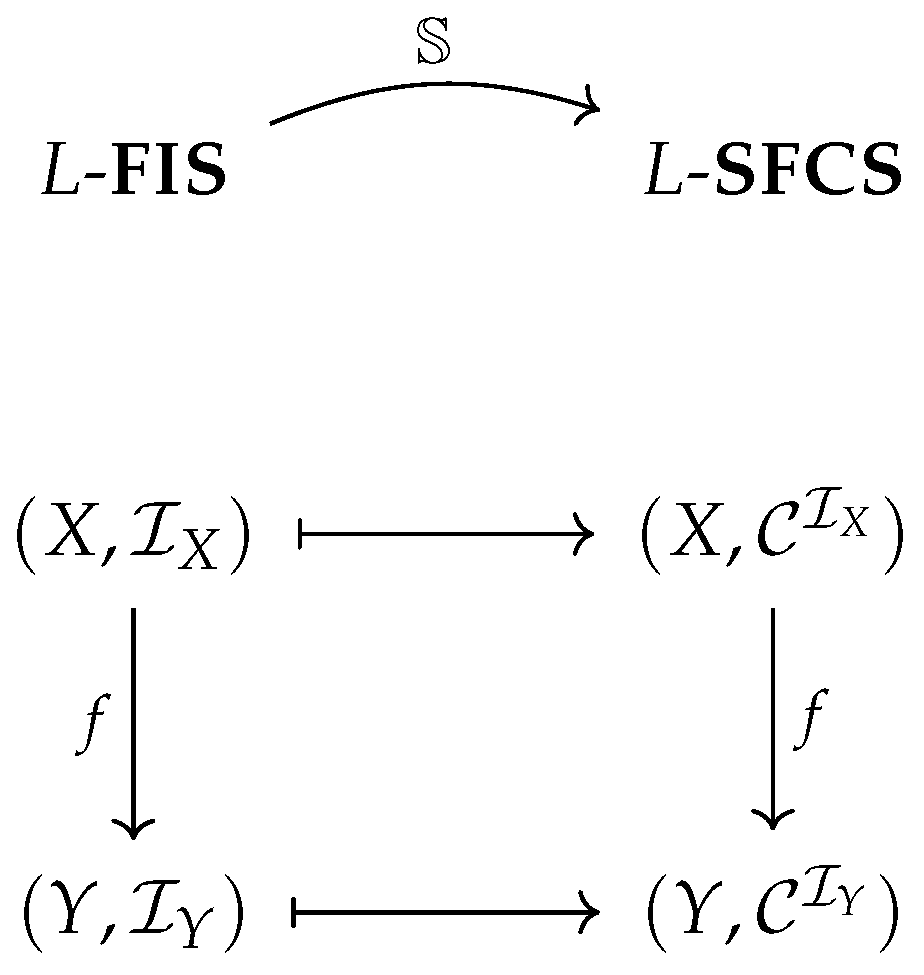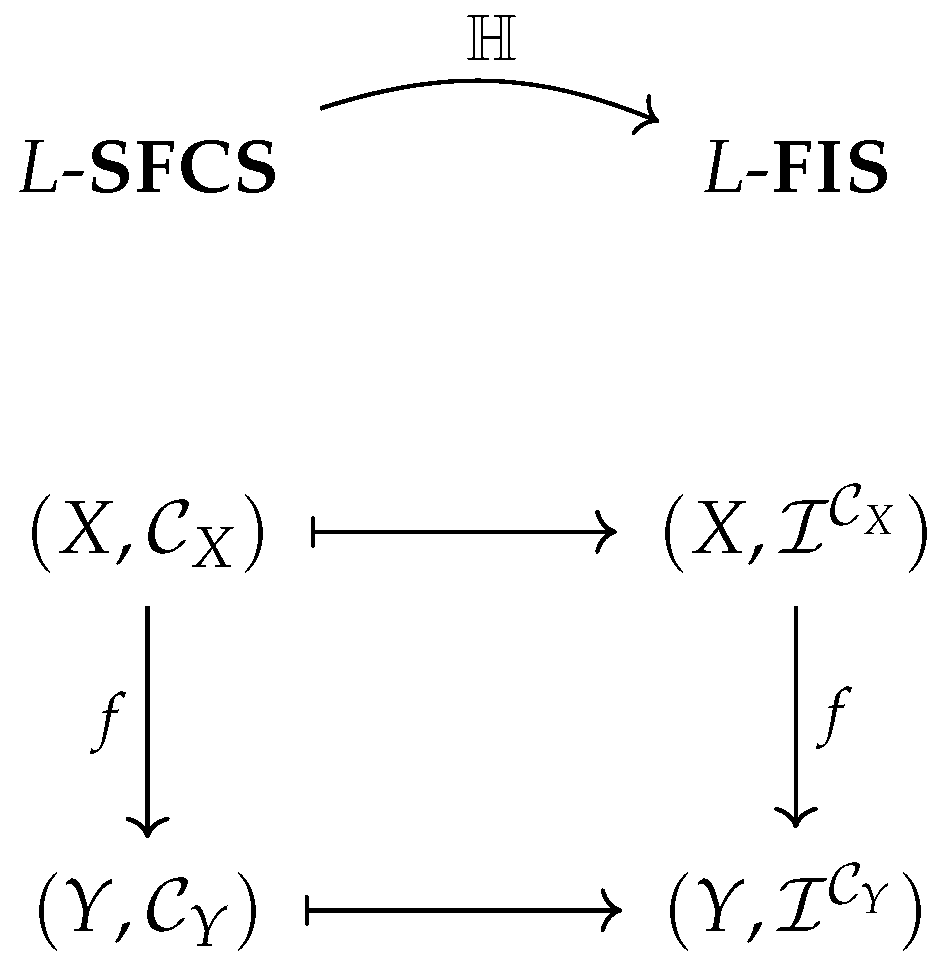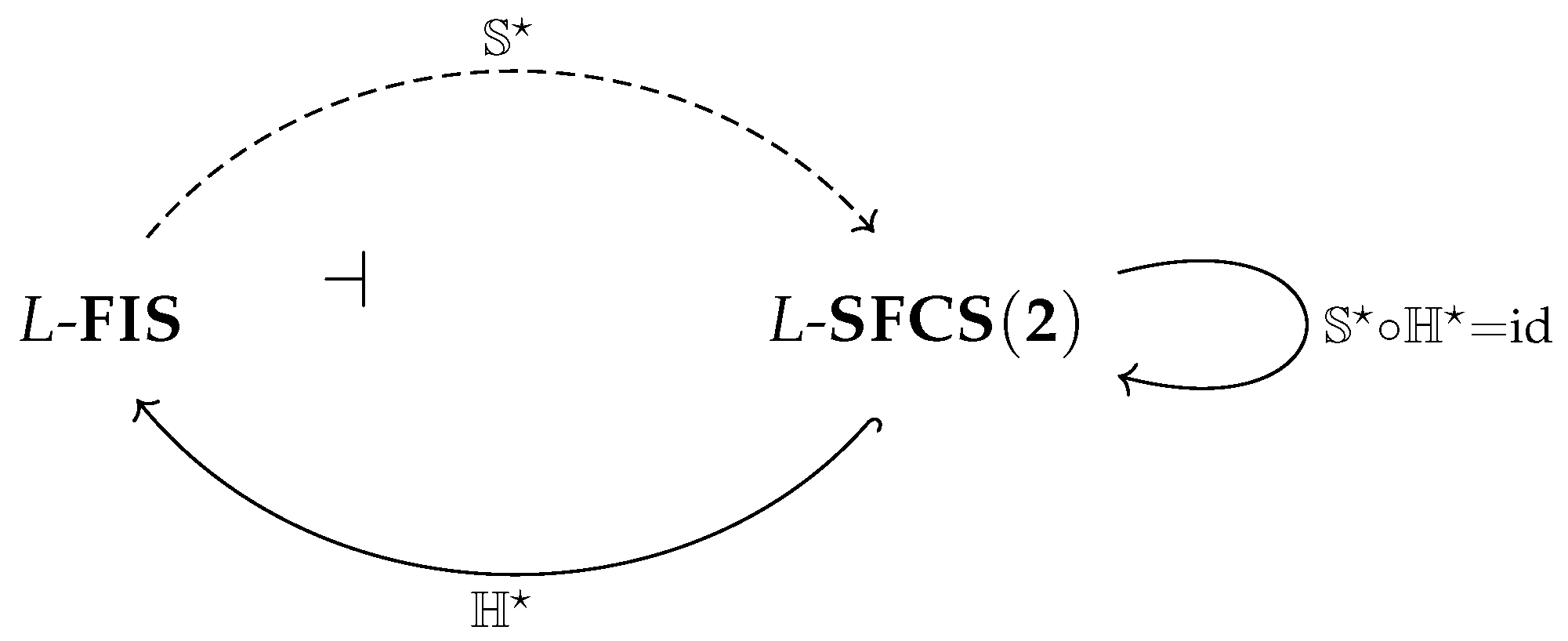1. Introduction
Convex structures play important roles in many research areas and have been widely used in many mathematical research areas, such as lattices [
1,
2], graphs [
3,
4], topological spaces [
5,
6], algebras [
7,
8], matroids [
9], and so on. As we all know, ordered structures and topological structures are closely related [
10,
11]. As a topology-like structure, convex structures and ordered structures are also closely related [
12]. Meanwhile, interval operators, as generalizations of intervals, provide a good method of describing convex structures. The purpose of this paper is to extend their relationship to a fuzzy setting.
Fuzzy set theory is an important mathematical tool to study uncertainty. The usefulness and versatility of this theory have amply been demonstrated by successful applications in a variety of problems [
13,
14,
15,
16,
17,
18,
19,
20,
21]. With the development of fuzzy mathematics, convex structures have been interrelated to fuzzy set theory. In terms of applications, fuzzy convexity has been extensively studied due to its unique advantages in handling imprecise information and has demonstrated significant value across multiple fields. Research indicates that this theory has been successfully applied in practical scenarios such as industrial control [
22], medical diagnosis [
23], and decision analysis [
24], fully showcasing its practicality and effectiveness in addressing complex real-world problems. While fuzzy convexity has proven valuable in practical domains, its theoretical foundations continue to be refined. Recent work has systematically investigated the relationships between lattice-valued interval operators, ordered structures, and convex structures [
25,
26,
27,
28,
29,
30]. These studies have primarily focused on completely distributive lattices with order-reversing involutions or commutative quantales, establishing important categorical relationships in these specialized settings. However, a significant gap remains in the more general framework of fuzzy convex structures: no study has investigated these relationships under the complete Heyting algebra setting, which occupies a crucial position between completely distributive lattices and general quantales in terms of both algebraic generality and logical expressiveness. This oversight limits the theoretical framework’s ability to model uncertainty in scenarios requiring intuitionistic logic features.
Motivated by this, we outline a more general theory of L-fuzzifying interval operators, L-fuzzy preorders and L-fuzzy convex structures using the structure of the complete Heyting algebra. To establish the relationships between these structures in this generalized environment, we employ Galois correspondence in category theory. This approach plays a significant role in establishing the relationships between different types of spatial structures, offering two fundamental advantages: (1) it can precisely characterize relationships between distinct spatial structures, and (2) the capacity for objects and morphisms in one category to bidirectionally derive or represent new information about the other.
Specifically, we focus on the relationship between L-fuzzifying interval operators and strong L-fuzzy convex structures via Galois correspondence. Additionally, we extend the classical concept of arity (a numerical feature indicating the ability of finite subsets to span the whole space via the hull operator) to the fuzzy setting. Specifically, within the lattice-valued environment of complete Heyting algebras, we establishes a precise definition for arity 2 strong L-fuzzy convex structures. Building upon this foundational definition, we investigate the relationship between arity 2 strong L-fuzzy convex structures and L-fuzzifying interval operators using Galois correspondence in category theory, aiming to establish a precise correspondence within this more general framework.
The structure of this paper is organized as follows. In
Section 2, we recall some basic concepts and notations used in this paper. In
Section 3, we investigate the categorical relationship between strong
L-fuzzy convex spaces and
L-fuzzifying interval spaces. In
Section 4, we give the method of mutual induction between strong
L-fuzzy convex structures and
L-fuzzy preorders. In
Section 5, we make a conclusion.
2. Preliminaries
Throughout this paper,
L denotes a complete Heyting algebra, which means that
L is a complete lattice, and for all
the following distributive law holds
The smallest element and the largest element in
L are denoted by 0 and 1, respectively. For a complete Heyting algebra
L, an implication operator
as the right adjoint for the meet operator ∧ can be defined as
Thus, the pair
forms a Galois correspondence on
L, that is,
For a complete Heyting algebra L, the following properties of hold: ,
- (1)
, ;
- (2)
;
- (3)
;
- (4)
;
- (5)
;
- (6)
;
- (7)
;
- (8)
.
For a nonempty set X, we denote the set of all L-subsets on X by . All algebraic operations on L can be extended pointwise to . The smallest element and the largest element in are denoted by and , respectively. For any nonempty subset , let denote the characteristic function of A. Clearly, can be regarded as an L-subset on X. For , the constant fuzzy set is given by for all . The partial order and all algebraic operators on L can be extended to by pointwise order. For and , write fuzzy sets , and by , and for all . We say a nonempty family is a directed subset of if for each , there exists such that .
Let be nonempty sets and be a mapping. Define and by for and , and for and , respectively.
Lemma 1. Let L be a complete Heyting algebra. For each directed subfamily , we have for each : Proof. Obviously,
Conversely,
Hence,
□
For each
, the subsethood degree [
31] of
A in
B is defined by
Now, we collect some properties of the subsethood degree in the following lemma.
Lemma 2 ([
31,
32])
. Let and . Then,- (1)
;
- (2)
;
- (3)
;
- (4)
;
- (5)
- (6)
;
- (7)
.
Notions related to category theory used this paper can be found in [
33].
Definition 1 ([
34])
. A subset of is called a convex structure on X if it satisfies the following conditions:- (C1)
;
- (C2)
If is nonempty, then ;
- (C3)
If is directed, then .
If is a convex structure on X, then the pair is called a convex space.
Definition 2 ([
34])
. The hull operator (briefly, ) of a convex space is defined by: Definition 3 ([
34])
. A convex structure on X is said to be of arity n, where and is the set of all positive natural numbers, ifwhere is the cardinality of F. In particular, if , then we say is of arity 2 Definition 4 ([
25,
27])
. An L-fuzzifying interval operator on X is a mapping if it satisfies the following conditions: for any ,- (LFT1)
;
- (LFT2)
.
For an L-fuzzifying interval operator on X, the pair is called an L-fuzzifying interval space.
A mapping between L-fuzzifying interval spaces is called L-fuzzifying-interval-preserving (L-FIP for short) provided that , .
The category whose objects are L-fuzzifying interval spaces and whose morphisms are L-FIP mappings will be denoted by .
Definition 5 ([
35])
. A strong L-fuzzy convex structure on X is a mapping which satisfies the following conditions:- (LFC1)
;
- (LFC2)
if is nonempty, then ;
- (LFC3)
if is directed, then ;
- (LFC4)
for each and , .
For a strong L-fuzzy convex structure on X, the pair is called a strong L-fuzzy convex space.
A mapping between strong L-fuzzy convex spaces is called L-fuzzy-convexity-preserving (L-FCP for short), provided that , .
The category whose objects are strong L-fuzzy convex spaces and whose morphisms are L-FCP mappings will be denoted by .
Remark 1. Definition 5 is a generalization of the definition of strong L-convex structures introduced by Pang in [32]. Definition 6 ([
36,
37])
. An L-fuzzy relation on X is a mapping An L-fuzzy relation on X is called an L-fuzzy preorder if it satisfies:- (LFR1)
reflexive if for any ;
- (LFR2)
transitive if for any .
For an L-fuzzy preorder on X, the pair is called an L-fuzzy preordered set.
A mapping between L-fuzzy preordered sets is called L-fuzzy-preorder-preserving (L-FRP for short) provided that , .
The category whose objects are L-fuzzy preordered sets and whose morphisms are L-FRP mappings will be denoted by .
3. L-Fuzzifying Interval Operators and Strong L-Fuzzy Convex Structures
In this section, we will discuss the relationship between categories and . Also, we will present the concept of arity 2 strong L-fuzzy convex structures and study its relationship with L-fuzzifying interval operators in a categorical sense.
Next, we study the relationship between categories L-SFCS and L-FIS.
Proposition 1. Let be an L-fuzzifying interval space and define byThen is a strong L-fuzzy convex structure on X. Proof. It suffices to verify that satisfies (LFC1)–(LFC4). Indeed,
(LFC1) Obviously.
(LFC2) Take any
. Then,
(LFC3) Take each directed subfamily
. Then,
(LFC4) Take each
and
. Then,
Hence,
is a strong
L-fuzzy convex structure on
X. □
Example 1. Let and be the unit interval, with the implication defined by Define as follows (Table 1): Then, it is easy to verify that is an L-fuzzifying interval operator on X. Further, define a mapping byFor convenience, let and for any , where . Through calculation, we obtain the following formulas:Then, it is easy to verify that is a strong L-fuzzy convex structure on X. Proposition 2. If is L-FIP, then is L-FCP.
Proof. Since
is
L-FIP, it follows that
Take each
. Then
This implies that
is
L-FCP. □
By Propositions 1 and 2, we obtain a functor
by
The action of functor
is illustrated in the following commutative diagram (
Figure 1):
Proposition 3. Let be a strong L-fuzzy convex space and define byThen is an L-fuzzifying interval operator on X. Proof. (LFT1) and (LFT2) are trivial. □
Proposition 4. If is L-FCP, then is L-FIP.
Proof. Since
is
L-FCP, it follows that
Take each
. Then,
This implies that
as desired. □
By Propositions 3 and 4, we obtain a functor
by
The action of functor
is illustrated in the following commutative diagram (
Figure 2):
Theorem 1.
is a Galois correspondence.
Proof. It suffices to prove that and . That is to say, we only need to verify (1) (2)
For (1), take each
. Then
This means that
For (2), take each
. Then
This shows that
as desired. □
This adjunction
is represented diagrammatically as follows (
Figure 3):
Next, based on the result in Theorem 1, we will further study the embedding and reflective properties with the categories and by using the properties of Galois correspondence.
Definition 7 ([
35])
. Let be a strong L-fuzzy convex space and define byThen is an L-ordered hull operator on X. Lemma 3. Let be a strong L-fuzzy convex space and be defined as in Definition 7. Then Proof. From Definition 7, we have
as desired. □
Definition 8. A strong L-fuzzy convex structure on X is called arity 2 if it satisfies:
- (LFA)
For an arity 2 strong L-fuzzy convex structure on X, the pair is called an arity 2 strong L-fuzzy convex space. The full subcategory of L-SFCS with arity 2 strong L-fuzzy convex spaces as objects is denoted by L-SFCS(2).
Remark 2. When , Definitions 7 and 8 are in agreement with the classical concepts given by Van De Vel in [34], respectively. Example 2. Let and be the unit interval, the corresponding implication is defined byDefine as follows:Then, it is easy to verify that is an arity 2 strong L-fuzzy convex structure on X. Next, we study the relationship between categories L-SFCS(2) and L-FIS.
Proposition 5. Let be an L-fuzzifying interval space and define byThen is an arity 2 strong L-fuzzy convex structure on X. Proof. By Proposition 1, we only need to prove that
satisfies (LFA), i.e.,
We first prove
for each
Take each
Then,
Hence, as desired. □
By Propositions 2, 3, 4, and 5, we know and are still functors. Then, we obtain the following result.
Theorem 2.
is a Galois correspondence. Moreover, is a left inverse of .
Proof. It is sufficient to prove that for any and for any . Indeed, it follows from Theorem 1, we only need to prove that for any
Firstly, by Proposition 3 and Lemma 3, we have
for each
. This implies that
This shows that
as desired. □
Corollary 1. The category L-SFCS(2)can be embedded in the category L-FISas a reflective subcategory.
This reflective subcategory structure is captured in the following diagram, which visualizes the adjunction
and the left inverse property (
Figure 4):
4. Strong -Fuzzy Convex Structures and -Fuzzy Preorders
In this section, we will discuss the connection between strong L-fuzzy convex structures and L-fuzzy preorders.
Now, we give a way of mutual construction of strong L-fuzzy convex structures and L-fuzzy preorders.
Proposition 6. Let be an L-fuzzy preordered set and define byThen is a strong L-fuzzy convex structure on X. Proof. It suffices to verify that satisfies (LFC1)–(LFC4). Indeed,
(LFC1) it is clear that
(LFC2) Take any
. Then,
(LFC3) Take each directed subfamily
. Then,
(LFC4) Take each
and
. Then,
Hence is a strong L-fuzzy convex structure on X. □
Proposition 7. If is L-FRP, then is L-FCP.
Proof. Since
is
L-FRP, it follows that
Take each
. Then,
This means that is L-FCP. □
Proposition 8. Let be a strong L-fuzzy convex space and define byThen is an L-fuzzy preorder on X. Proof. It is clear that
(LFR2) Take each
. Then,
Hence is an L-fuzzy preorder on X. □
Proposition 9. If is L-FCP, then is L-FRP.
Proof. Since
is
L-FCP, it follows that
Take each
. Then,
This implies that
is
L-FRP. □
Proposition 10. Let be a strong L-fuzzy convex space. Then
Proof. Take each
. Then,
It means that
as desired. □
Finally, we shall show that a strong L-fuzzy convex structure generated by an L-fuzzy preorder is an arity 2 strong L-fuzzy convex structure.
Proposition 11. Let be an L-fuzzy preordered set and define byThen, is an arity 2 strong L-fuzzy convex structure on X. Proof. By Proposition 6, we only need to prove that
satisfies (LFA), i.e.,
We first prove
for each
Take each
Then,
It follows that
Conversely,
Hence,
as desired. □
5. Conclusions
In this paper, we showed that there is a Galois correspondence between the category of strong L-fuzzy convex spaces and that of L-fuzzifying interval spaces. Further, we presented the concept of arity 2 strong L-fuzzy convex structures and proved that the category of arity 2 strong L-fuzzy convex spaces can be reflectively embedded into that of L-fuzzifying interval spaces. Finally, we investigated the relationship between strong L-fuzzy convex structures and L-fuzzy preorders. While these results lay a solid foundation within the framework of complete Heyting algebras, we acknowledge certain limitations and outline promising avenues for future research to broaden the scope and impact of this work:
The current study assumes L to be a complete Heyting algebra. More general algebraic structures (e.g., residuated lattices or quantales) may be necessary for wider practical applications, particularly in domains like advanced fuzzy logic.
Future Direction 1: In addition to interval operators, there are many mathematical structures closely related to convex structures that are worth studying. We will also consider the fuzzy forms of other mathematical structures related to convex structures and study their relationships in lattice-valued environments through Galois correspondence in category theory.
Future Direction 2: Inspired by classical convex spaces and convex preference models in economics, we will define a convexity degree for preference relations using the -cut method and investigate the properties of fuzzy convex preferences under various fuzzy convex structures.









